
Fig. 1. a. Visual and auditory regions of interest (ROIs). b. Responses in a combination of visual (e.g., early dorsal visual stream; Fig. 1a, middle panel) and auditory regions were used to predict responses in the rest of the brain using MVPN. c. In order to identify brain regions that combine responses from auditory and visual regions, we identified voxels where predictions generated using the combined patterns from auditory regions and one set of visual regions jointly (as shown in Fig. 1b) are significantly more accurate than predictions generated using only auditory regions or only that set of visual regions.
I’m excited to share my 1st first-authored paper, “Distinct portions of superior temporal sulcus combine auditory representations with different visual streams” (with @mtfang.bsky.social and @steanze.bsky.social ), now out in The Journal of Neuroscience!
www.jneurosci.org/content/earl...
02.10.2025 15:20 — 👍 20 🔁 10 💬 1 📌 0
Refusing to release the requested data on how these questions performed undermines the Census Bureau’s scientific integrity and prevents accountability when LGBTQ+ communities are left invisible. (4/4)
23.09.2025 16:59 — 👍 1 🔁 0 💬 0 📌 0
Congress allocated $10 million, the Census Bureau tested nearly half a million households, and now the results are being unlawfully suppressed. (3/4)
23.09.2025 16:59 — 👍 0 🔁 0 💬 1 📌 0
Policymakers, researchers, and multiple federal agencies requested this testing to help enforce civil rights and better understand and address disparities in health, education, employment, and other areas affecting LGBTQ+ Americans. (2/4)
23.09.2025 16:59 — 👍 0 🔁 0 💬 1 📌 0
Democracy Forward & I filed a lawsuit against the U.S. Census Bureau, seeking the release of data from its testing of sexual orientation & gender identity questions in the nation's most important annual demographic survey, key to upholding LGBTQ+ rights.
democracyforward.org/updates/sogi...
(1/4)
23.09.2025 16:59 — 👍 3 🔁 1 💬 2 📌 0
The results open a path for new interventions that don’t just target stereotypes but also attempt to recalibrate biased visual perception directly, with the hopes of mitigating such high-stakes misjudgments under stress and uncertainty.
(6/6)
19.09.2025 15:19 — 👍 9 🔁 2 💬 0 📌 0
While past work has generally assumed such weapon-identification biases involve an accurate perception of the object but then a racially biased impulse that is difficult to control, our findings suggest that part of the problem is a temporary visual distortion as well.
(5/6)
19.09.2025 15:19 — 👍 6 🔁 2 💬 1 📌 0
These neural representational shifts predicted subjects' delays in recognizing these tools as tools, rather than weapons, suggesting an initial tendency to perceive them as weapons.
(4/6)
19.09.2025 15:19 — 👍 4 🔁 2 💬 1 📌 0
Using neural decoding techniques, we find that when subjects saw a Black man’s face before an image of a tool, their brain’s object-processing regions shifted toward a weapon-like representation.
(3/6)
19.09.2025 15:19 — 👍 4 🔁 2 💬 1 📌 0
Unarmed Black people in the US are 3X more likely than unarmed White people to be shot and killed by police. In many tragic cases, unarmed Black men were holding innocuous objects like a wrench, wallet, or cell phone when fatally shot by an officer.
(2/6)
19.09.2025 15:19 — 👍 5 🔁 2 💬 1 📌 0

New findings from my lab in Nature Communications suggest that racial stereotypes can lead the brain's perceptual system to temporarily "see" weapons where they don't exist.
Led by: @dongwonoh.bsky.social
Paper: www.nature.com/articles/s41...
(1/6)
19.09.2025 15:19 — 👍 74 🔁 27 💬 2 📌 5
Three @spspnews.bsky.social members will discuss their grant terminations and next steps, followed by Q&A, story sharing, and community discussion.
Moderator: Cynthia L. Pickett, Professor; Past SPSP President
Speakers: @lkfazio.bsky.social, @freemanjb.bsky.social, and @frankikung.bsky.social
09.09.2025 18:48 — 👍 5 🔁 3 💬 0 📌 0
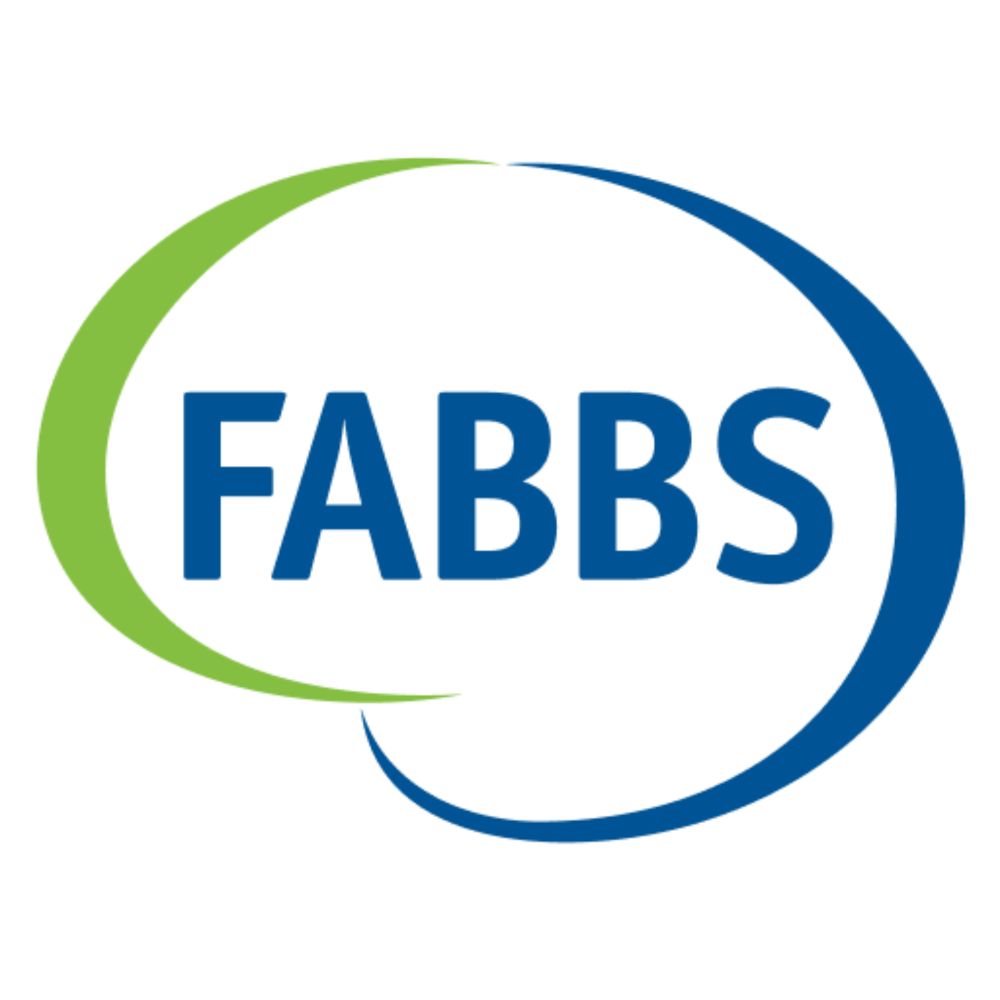
We’re Hiring: Technology Policy Fellow – FABBS
Location: Washington, D.C. (hybrid) Salary: Approximately $7,000 per month Start Date: September 15, 2025 Duration: 3 months, with potential for longer Position
The Federation of Associations in Behavioral and Brain Sciences (@fabbs.org) is searching for a short-term technology policy fellow. Great opportunity for a new PhD interested in policy, maybe before a research postdoc or faculty position:
fabbs.org/news/2025/08...
15.08.2025 15:05 — 👍 11 🔁 13 💬 0 📌 1
First paper from my lab out @commspsychol.nature.com
www.nature.com/articles/s44271-025-00275-w
Latent factor models are popular for mental representation of people, e.g. warmth & competence
But we show in naturalistic contexts, more complex representations are needed: high-dimensional networks
08.07.2025 01:37 — 👍 27 🔁 9 💬 2 📌 0
Congrats!
30.06.2025 22:25 — 👍 2 🔁 0 💬 0 📌 0
Paper in @pnas.org in which @d-melnikoff.bsky.social and I provide evidence for model-based effects on automatic evaluation. This was a super fun “adversarial” collaboration with 0 adversariality. It may have been nice to be right, but getting it right is nearly as nice: www.pnas.org/doi/10.1073/...
21.06.2025 01:52 — 👍 48 🔁 9 💬 2 📌 0
Curious for any reactions/feedback!
19.06.2025 01:58 — 👍 0 🔁 0 💬 0 📌 0
We think it's important to view impressions not so much as drawing on a fixed low-dimensional structure but as emerging in a combinatorial fashion out of the dynamics of a high-dimensional space. This approach may also be valuable for thinking about other dimensional models in social cognition (8/8)
18.06.2025 21:58 — 👍 3 🔁 0 💬 0 📌 0
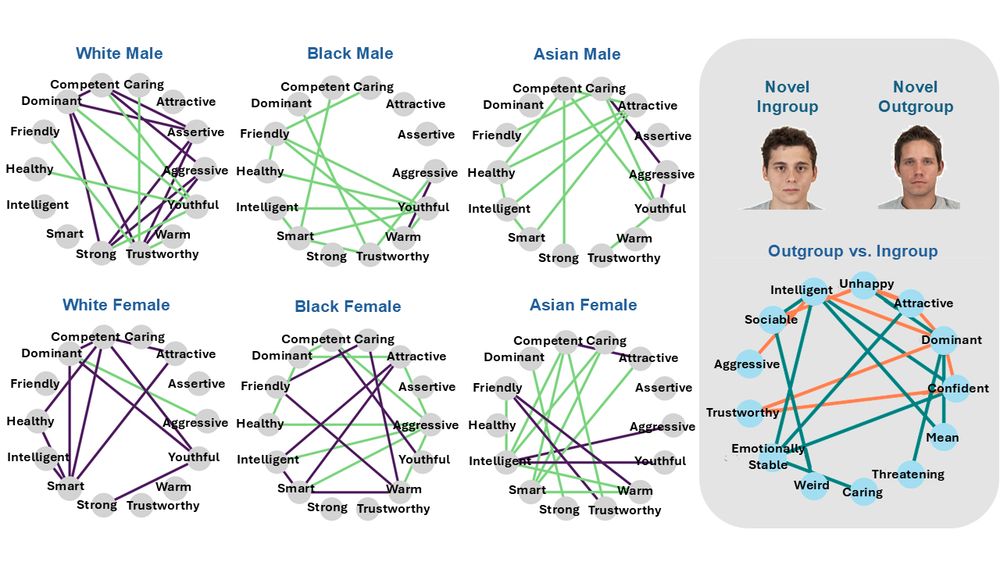
The model can explain growing findings:
▪️cross-cultural & individual perceiver variation
▪️variation by targets' race/gender/groups
And makes novel predictions:
▪️"proximal" vs. "distal" traits in cascades (competent → intelligent → creative)
▪️earlier activation of putatively latent dimensions (7/8)
18.06.2025 21:58 — 👍 2 🔁 0 💬 1 📌 0
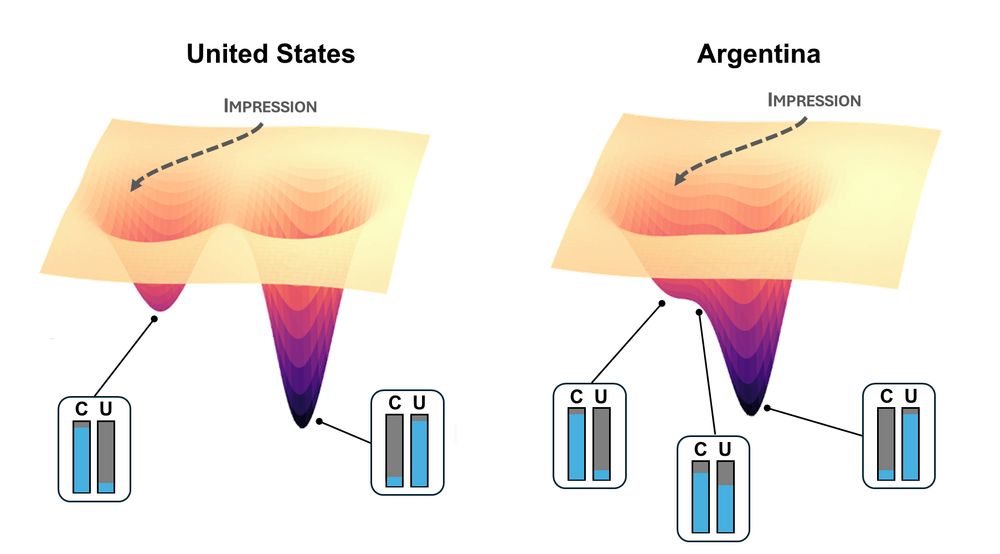
In the model, the structure of trait relationships (e.g., trustworthiness–dominance) can change due to targets or context and cultural and individual learning. Top-down factors—like goals, stereotypes, or attention—reshape the attractor landscape, influencing which traits become most stable. (6/8)
18.06.2025 21:58 — 👍 1 🔁 0 💬 1 📌 0
Here the trustworthiness/warmth dimension isn’t a latent mechanism or have a privileged functional/cognitive status—it’s an emergent pattern from correlated traits. That’s why it appears in PCA or factor analysis. But we argue that it’s only a mere snapshot of a fluid, high-dimensional space (5/8)
18.06.2025 21:58 — 👍 1 🔁 0 💬 1 📌 0
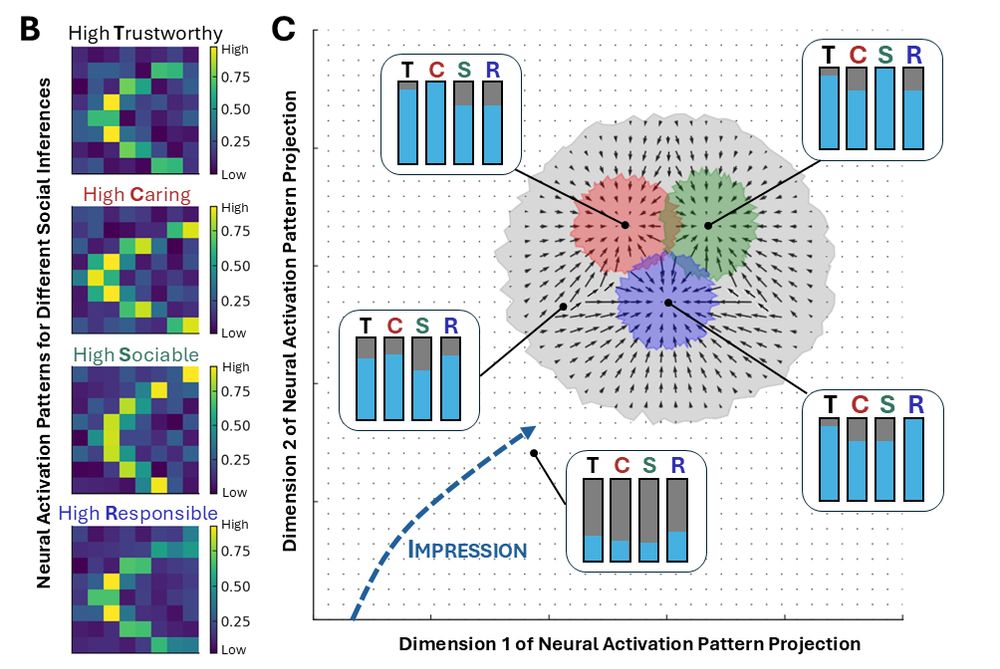
How does it work? You encounter another person. Features trigger many trait concepts (e.g., sociable, caring, competent), which activate each other or compete, influenced by top-down goals & higher-order processes. The network settles into a stable neural pattern, resulting in impressions. (4/8)
18.06.2025 21:58 — 👍 3 🔁 0 💬 1 📌 0
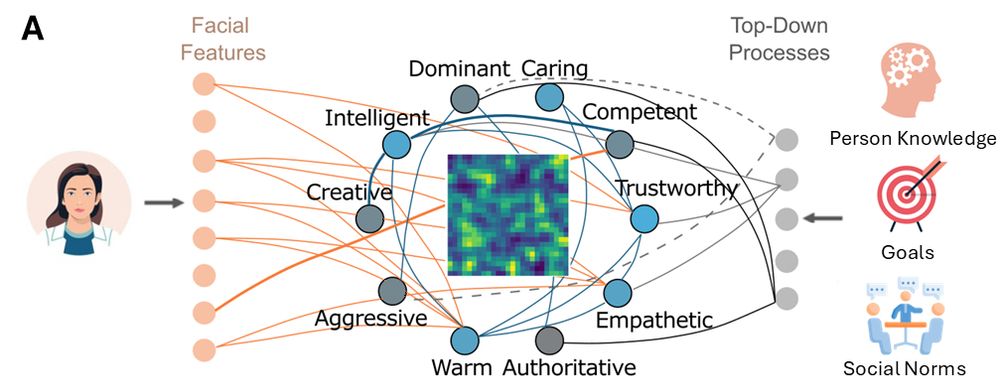
Instead, using attractor neural networks, we propose a high-dimensional model. In the brain, social impressions would operate as dynamic trajectories in a neural-state space that can be shaped by sensory cues, conceptual associations, and higher-order social cognition.
(3/8)
18.06.2025 21:58 — 👍 4 🔁 0 💬 1 📌 0

How do we infer countless traits? Models have treated trait perception like color vision: impressions arise from combinations of, e.g., “red” (trustworthy), “green” (dominant), & "blue" (youthful). But unlike color, there’s no evidence for this, and we question the value of latent dimensions (2/8)
18.06.2025 21:58 — 👍 3 🔁 0 💬 1 📌 0
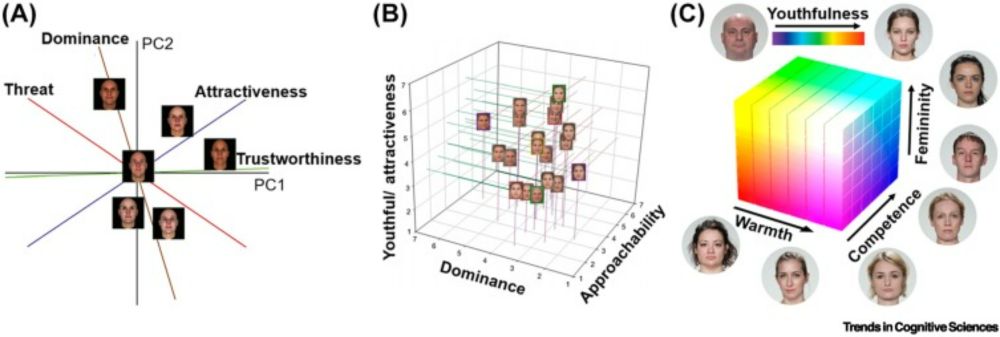
A high-dimensional model of social impressions
People form social impressions from visual cues such as faces, which are argued by
various models to arise from some limited set of fixed dimensions (e.g., trustworthiness
and dominance). We argue tha...
In a TiCS paper, @chujunlin.bsky.social & I propose a high-dimensional model of social impressions.
Existing models focus on 2–4 latent dimensions (e.g. trustworthy/warm), but they often fall apart across different contexts, cultures, & perceivers. We need a paradigm shift.
shorturl.at/7GD1n (1/8)
18.06.2025 21:58 — 👍 56 🔁 18 💬 3 📌 1
Want your NIH and NSF program officers and division directors to be fired and turned into political appointees?
Deadline extended: 3 days left! Already 33,000+ public comments
Comments can tank a proposed rule in court.
📣 Oppose the rule with a brief comment: shorturl.at/WKuBj
04.06.2025 23:13 — 👍 120 🔁 109 💬 3 📌 5
So thrilled @youngkihong.bsky.social will be starting up at UC Boulder!
02.06.2025 17:07 — 👍 4 🔁 0 💬 0 📌 0
#ScienceNotPolitics #ProtectScience #StandUpForScience #NSF #NIH
22.05.2025 18:29 — 👍 2 🔁 1 💬 0 📌 0
It's currently at 19,430+ public comments, but the deadline is now extended to June 7.
The agency may be worried the large, well-reasoned opposition could tank the final rule in court—and is buying time to flood the docket with support.
Keep it coming!
22.05.2025 18:28 — 👍 7 🔁 0 💬 1 📌 1
PhD Student, Boston University Brain Behavior Cognition | he/they 🏳️🌈
Human Curiosity, Exploration, & Information Seeking: Why do we seek out knowledge and when do we avoid it?
Formerly @MGHPsychiatry & @UMassLowell
https://www.psyc.dev
🇳🇱 | PhD from Columbia | Digital nomading for a bit | How places and changes influence social cognition and well-being | Social Data Science
into brain evolution & development, open science, art & science https://www.youtube.com/watch?v=6hMNZHsrNHw, music, making, javascript, contemporary dance https://www.youtube.com/watch?v=OZfHj7F2FzQ
website: katjaq.github.io
Affective neuroscientist studying how & why we feel from womb-to-tomb.
Chancellor’s Leadership Professor of Psychology @ UC Davis
Core Scientist @ the California National Primate Research Center
blissmoreaulab.ucdavis.edu
CNY -> Chestnut Hill -> Yolo
PhD candidate studying perception of naturalistic facial expressions across lifespan | Former opera singer | Interested in multimodal communication (vocal/facial) & MSI, affective breathing, interoception 🫁🫀
NBC News National Reporter. Iowa raised, Los Angeles living. Bad at social media, good at petting animals. On Signal: tylerkingkadenbc.20
tyler.kingkade[at]nbcuni.com
https://www.tylerkingkade.com/
https://www.nbcnews.com/pages/author/tyler-kingkade
President @ucs.org. Previously: USDOT, White House OSTP, @500womensci.bsky.social. Environmental engineer. Mom. Cyclist. Public Transit Enthusiast. Views my own. She/her.
Mobilizing the fight for science and democracy, because Science is for everyone 🧪🌎
The hub for science activism!
Learn more ⬇️
http://linktr.ee/standupforscience
Evolutionary biologist, runner, writer, gay. Not necessarily in that order. LAX and SEA
Signal @jbyoder.82
Also ecoevo.social/@jby, jbyoder.org
Cutting-edge research, news, commentary, and visuals from the Science family of journals. https://www.science.org
Associate Prof at U of Houston, studying how to motivate students in STEM. Academic mama. Bookworm. Every mistake, we must surely be learning. She/her/hers. Views expressed here are my own.
Computational Social Neuroscientist, Assistant Professor at Adelphi University, New Yorker at-large
Researcher of online rumors & disinformation. Former basketball player. Prof at University of Washington, HCDE. Co-founder of the UW Center for an Informed Public. Personal account: Views may not reflect those of my employer. #RageAgainstTheBullshitMachine
fed govt: public health, public safety. deep breaths, long horizons.
+ science comms + strategic comms + public sociology
Prof at Princeton, Trans Youth Project
UGA Psychology prof, PI of UGA Infant Lab. Higher Ed, developmental science, prenatal dev, Georgia life. Missouri native and Jayhawk at heart. Lover of podcasts, piano, and professors who use their tenure (while it still exists).
psychology lecturer at Stirling Uni
person perception, social groups, inequality
dogs, sci fi, punk 🏳️🌈🇮🇸
https://rthorabjornsdottir.wordpress.com/
Director, Knight First Amendment Institute at Columbia University; Exec Editor, Just Security; former ACLU. knightcolumbia.org.
Senior Lecturer (Associate Professor) at the University of Bath. Researcher of social cognition, attitudes, stereotyping and prejudice, diversity, equity, and inclusion, colonialism. 🏳️🌈 Based in Bristol, UK.










